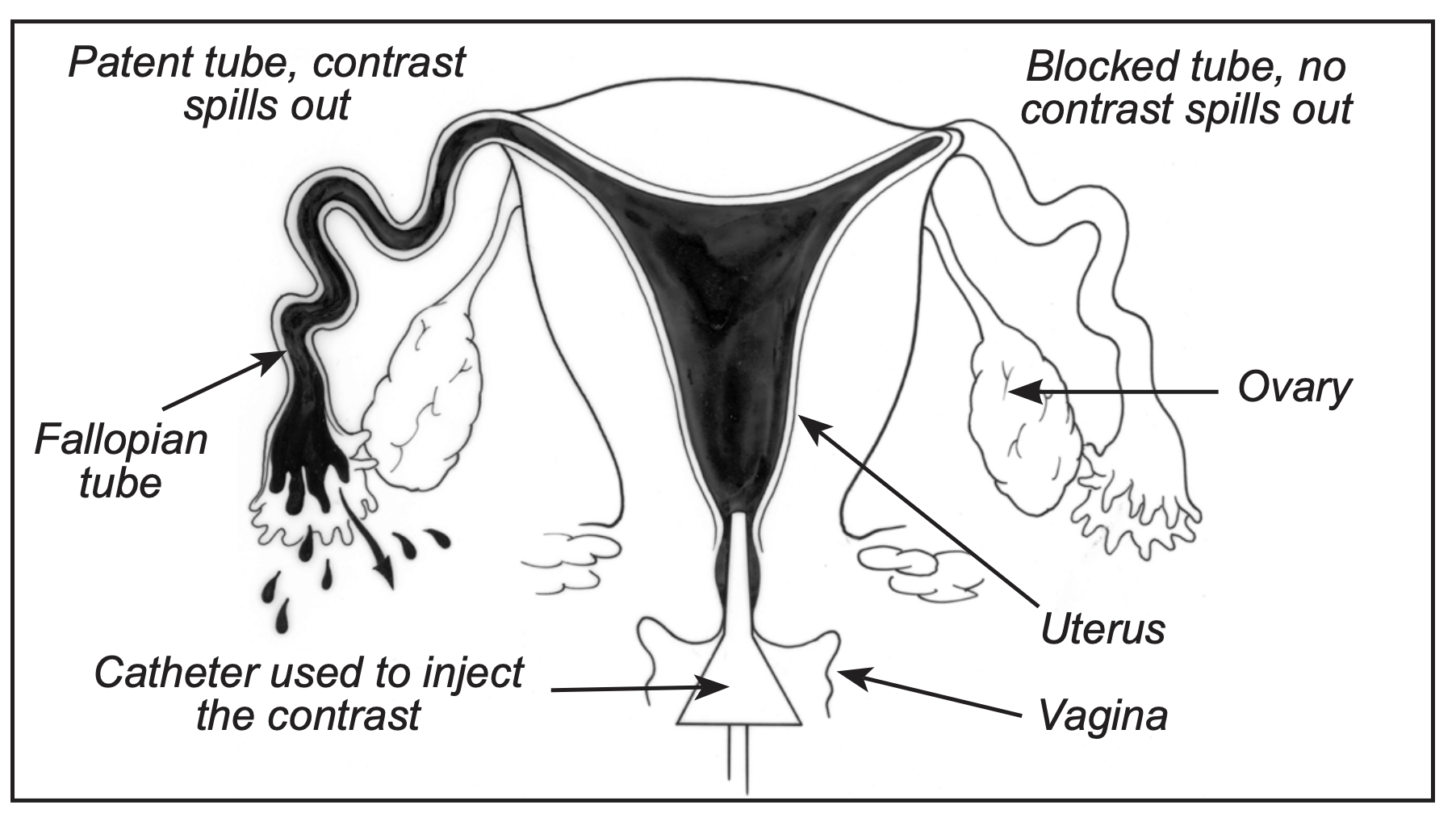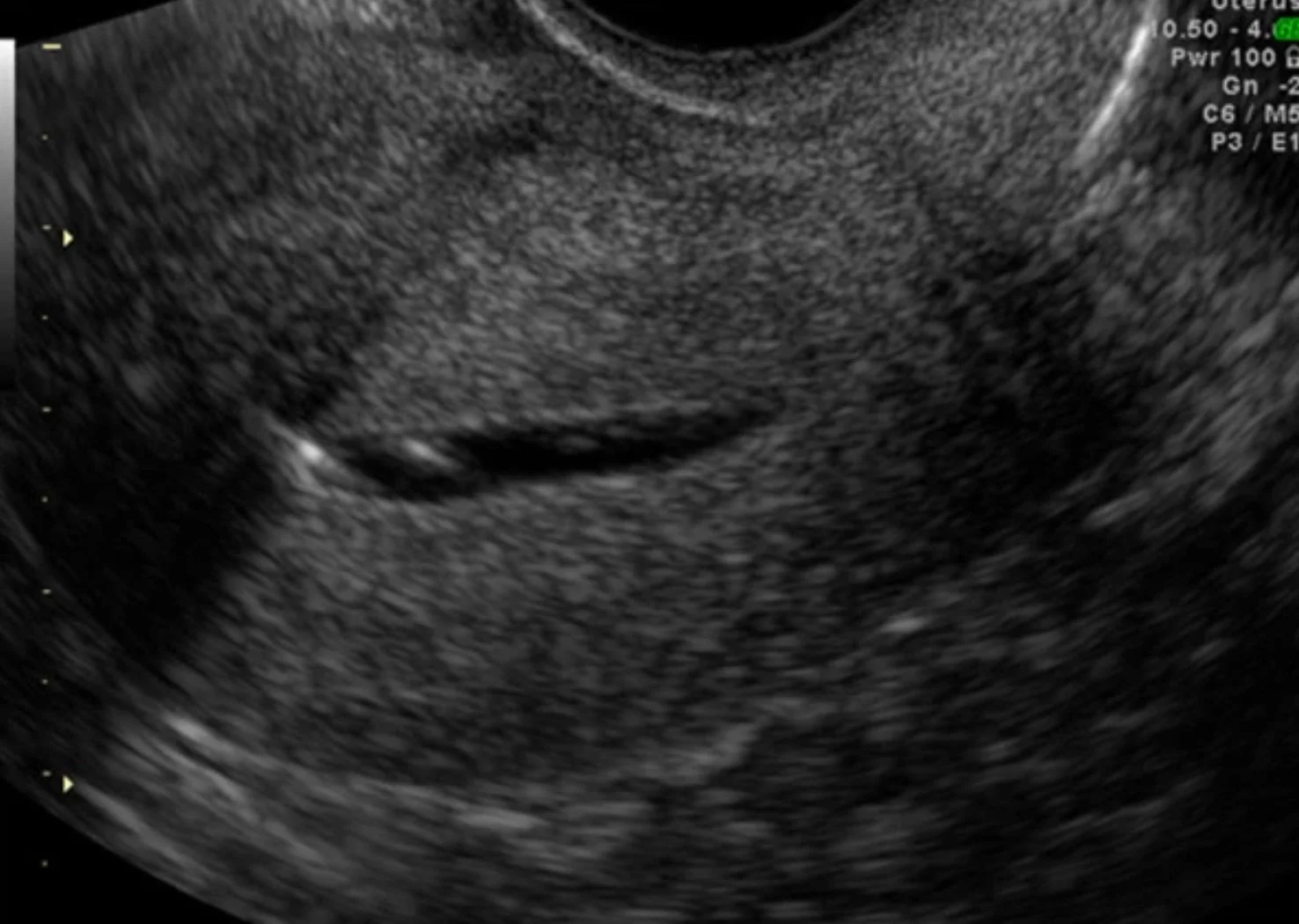Non-surgical fallopian tube assessments
Hysterosalpingogram (HSG) showing open fallopian tubes, with spillage into the abdomen. The mild indentation at the top reveals an arcuate-shaped uterus, too.
Are my tubes blocked?
Although laparoscopy is known as the ‘gold standard’ way of checking fallopian tubes, there are ways to see if they are open that don’t involve surgery. The advantage of laparoscopy is that it can tell you not only if they are open, but also about nearby structures and whether they are injured or stuck in adhesions or scar tissue which could affect fertility. Laparoscopy will tell you if there is endometriosis present or not, another fertility factor which can’t usually be seen on these procedures - unless the endometriosis is severe.
So what about the non-invasive options that don’t involve surgery? The two discussed below are hysterosalpingogram (HSG) and hystero-salpingo contrast sonography (HyCoSy)
Hysterosalpingogram
This test is often used to examine the uterus and fallopian tubes, which are key parts of your reproductive system. Here's what you need to know.
What is a Hysterosalpingogram (HSG)?
An HSG is a type of X-ray test. This test helps us see the inside of your uterus and fallopian tubes. It can reveal if there are any problems that could make it difficult for you to get pregnant. See the image at the top of the page which shows a HSG.
Why might I need an HSG?
I might suggest an HSG if you've had trouble becoming pregnant and we’re trying to find out why. Or if we discover that you aren’t ovulating but need to know your tubes are open before we start ovulation induction drugs. The HSG can help identify issues like blocked fallopian tubes or abnormalities in the shape of your uterus.
How do I prepare for the procedure?
Before your HSG, the radiology provider will provide specific instructions. You may be asked to avoid sexual intercourse for a certain period of time before the test. It's important to have a full bladder before the procedure as it can make it easier to take the X-ray.
What happens during the procedure?
During the HSG, you will lie on an X-ray table. The radiologist will pass a speculum into your vagina and a narrow tube through your cervix (the opening to the uterus). A dye is then gently pushed through, filling your uterus and passing to the fallopian tubes. This dye makes it possible for the X-ray machine to see your uterus and fallopian tubes clearly. Sometimes you need to shift your position to achieve side views.
The procedure usually takes about 30 minutes. You may feel some discomfort, similar to menstrual cramps when the dye is injected. Some people find it very uncomfortable so taking pain relief beforehand can help. Cramps can last from 5-10 minutes to a couple of hours.
What can I expect after the procedure?
After the procedure, you may experience some light spotting or mild cramping. This is normal. You should have someone available to drive you home and you can typically resume your normal activities by the following day.
I will see the results after the radiologist has reported on the X-ray. If the dye was able to pass freely through your uterus and out your fallopian tubes, this suggests they are open. If the dye didn't pass through completely, this might indicate a blockage or other issue. Blockages need to be confirmed by laparoscopy and dye testing.
Are there any risks?
While the HSG is generally a safe procedure, like any medical procedure, there are a few risks. These can include allergic reactions to the dye, infection, or mild to moderate pain during or after the procedure. If you experience infection, it would occur a few days afterwards and present with fever or unusual discharge. The risk of infection is low but not zero and it’s more common if you’ve had an STI recently. Discuss this with Dr Tucker or the radiologist if you’re concerned. Overall, the risks are generally less than with laparoscopy, but you get less information.
Does HSG enhance fertility?
This is controversial and some studies have shown a slight increase in fertility in the three months after normal HSG. Usually, the procedure is done for diagnostic reasons only.
Hystero-salpingo contrast sonography (HyCoSy)
HyCoSy is an ultrasound procedure often used to evaluate infertility issues by examining your fallopian tubes and other pelvic organs.
What does the HyCoSy involve?
During a HyCoSy, a fizzy salt water (saline) solution is introduced into your uterus in a similar way to the dye discussed above using a speculum. This solution is tracked as it moves through your fallopian tubes with the help of a soft plastic tube, or catheter, placed inside your cervix, and an internal ultrasound. The bubble water creates bright echoes, allowing your fallopian tubes to be clearly seen and reveal any blockages. This image is further enhanced with colour Doppler (blood flow) imaging.
First, a saline solution without any bubbles is inserted to check for any problems. Then, the bubbly saline is used.
The procedure is typically carried out between days 6 to 12 of your menstrual cycle. This timing helps better assess the lining of your uterus and also ensures there's no risk of a potential pregnancy in the tube.
HyCoSy showing a normal uterus shape, the fallopian tubes open (black & white arrows) and fluid beneath the uterus, indicating open tubes and water flow into the abdomen
Will the procedure cause discomfort?
You might experience some discomfort during this procedure, similar to menstrual cramps. If one or both of your fallopian tubes are blocked, this discomfort can be more intense. Pain relief options will be discussed before the procedure. Around 1-in-20 people consider the pain severe.
Usually, it’s suggested to take ibuprofen tablets, a type of NSAID pain relief an hour or two beforehand (if they’re normally safe for you). If your periods tend to be heavy, it’s normally recommended to arrange for someone else to drive you home after the procedure.
What to expect after a HyCoSy
As with HSG, the risks of the procedure are low. Most women have no issues following their HyCoSy. However, it's good to be aware of what's normal and what might indicate a problem:
Normal post-procedure experiences include:
Abdominal cramps for up to an hour
Light bleeding for 3-4 days, manageable with a panty-liner or pad. Please avoid using tampons to minimise infection risk.
It's not normal to experience:
A foul-smelling vaginal discharge
A fever over 38 degrees Celsius
If you notice any of these symptoms, it could indicate an infection. Please contact the clinic where your procedure was performed, or your GP or my clinic number for appropriate assessment and treatment.
Finally, it's not necessary to abstain from sexual intercourse after the procedure.
So, which should I choose?
HyCoSy is a more modern procedure and ultrasound imaging may give additional information about other pelvic organs. It has a high sensitivity for tubal blockage and does not expose you to radiation. For this reason, many people choose HyCoSy as a first-line test.
HSG may be slightly less expensive and is still considered a very reasonable and widely used screening test for tubal blockage as part of fertility workup. The two have not been compared head-to-head in medical research to tell us which is ‘best’ overall in terms of accuracy.
Locally, HSG is available at Queensland Xray and HyCoSy at Women’s Health Circle. Contact them directly for fee information and anticipated Medicare rebate.




